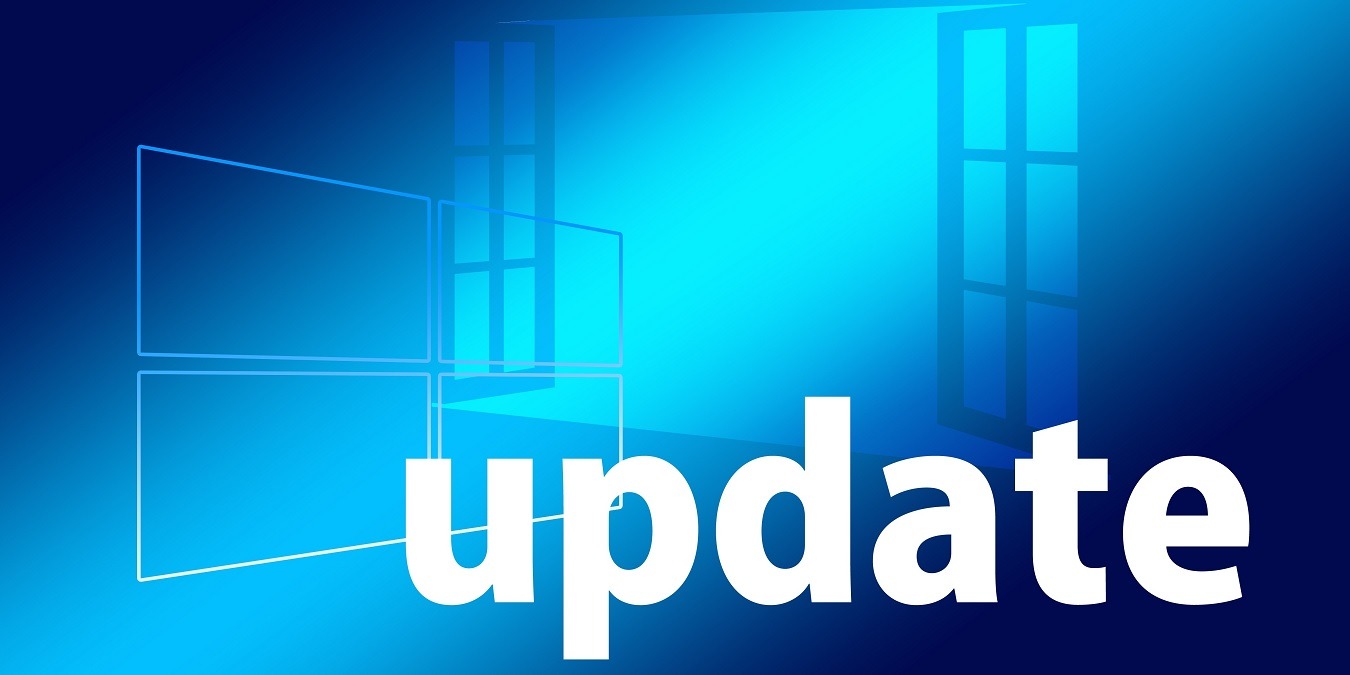
Windows 10 and Windows 11 have had their share of problems. The operating system had over 1200 security vulnerabilities just in 2022. Microsoft quickly moves in to fix many of these security holes in the system, so it’s essential to stay up to date. Yet, Windows updates can bring their own problems. This guide shows what to do when an update does more harm than good.
Note: if a problem here is marked as “FIXED,” it means Microsoft has rolled out an update that fixes the problem, and the solution is simply to make sure your system is fully updated. If a problem is not yet “FIXED,” then either read that entry for workarounds to that specific problem or scroll down the page for advice on how to roll back updates.
- [Not Fixed] November 14, 2023, Windows 11 23H2, KB5032190 Cumulative Update
- [Not Fixed] October 31, 2023, Windows 11 23H2, KB5031455 Cumulative Update
- [Fixed] October 31, 2023, Windows 11 22H2, KB5031455 Cumulative Update
- [Fixed] October 10, 2023, Windows 11 22H2 KB5031354 Cumulative Update
- Error Code 0x800f0831
- [Fixed] November 14, 2023, Windows 10 Version 22H2, KB5032189 Servicing Stack Update
- [Fixed] October 26, 2023, Windows 10 Version 22H2, KB5031445 Servicing Stack Update
- [Fixed] Error 0x80070422
- How to Fix and Avoid Broken Windows Updates
- Install Optional Updates
- Uninstall Windows Updates
- How to Roll Back Windows Builds
- Check Your Windows Build
- Pause Windows Updates
- Completely Block Windows Updates
[Not Fixed] November 14, 2023, Windows 11 23H2, KB5032190 Cumulative Update
Problems: lack of update notifications | confusing update
Microsoft’s Windows 11, version 23H2, KB5032190 update (also simply known as the Windows 11 2023 Update), is an important release in its “23H2” OS build. Most users should automatically migrate without any issues. There is one key prerequisite. You should already be on version 22H2, KB5031455, which was launched on October 31, or another later cumulative version.
The problem with this update is that many users could miss the notification, even though they migrated to a higher update for version 22H2.
To check the Windows 11 update you’re currently using, go to Settings -> System -> About, and check the version number. If it says 23H2, you’re good to go. However, if you’re still on 22H2, you may need an enablement package from KB5027397, which installs through “Windows Update Catalog” (see next section).
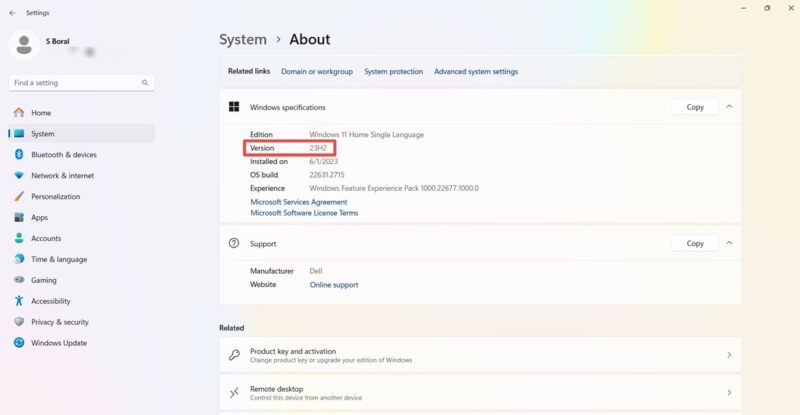
You can also reinstall Windows 11 from the cloud using Windows installation assistant, ISO, media creation or another tool. This will install the latest version of Windows 11, which Microsoft offers online.
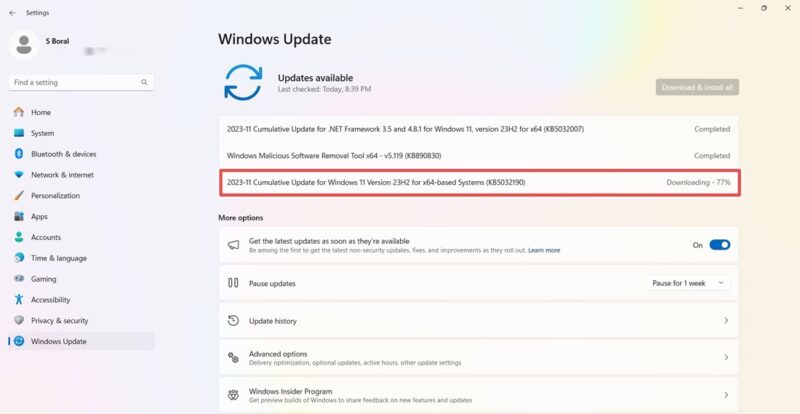
While downloading, if the Windows Update standalone installer says, “The update is not available on your computer,” it means you already have the latest update.
IMPORTANT: by February 27, 2024, all Windows 11 users should compulsorily migrate to version 23H2, as the non-security support for version 22H2 will end by this cutoff date.
[Not Fixed] October 31, 2023, Windows 11 23H2, KB5031455 Cumulative Update
Problems: lack of update notifications | install errors | Copilot compatibility problems
With KB5031455, Microsoft has officially launched its Moment 4 update under version 23H2. This should not be confused with an identical update number under version 22H2 (see below).
The 23H2 update comes with exciting new features that we only had a sneak preview of in 22H2. This includes Windows Copilot, capable of displaying the ChatGPT-based Bing Chat results on your desktop. Also, the Windows Backup app backs up all your folders and installed apps to the OneDrive cloud.
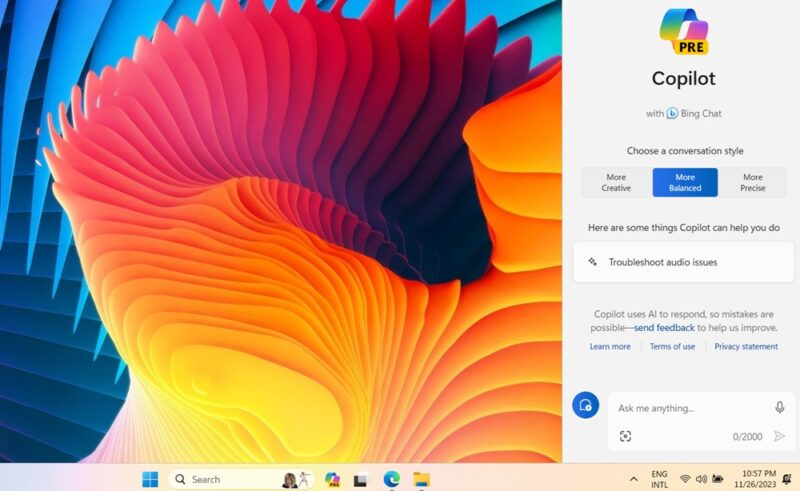
The biggest challenge with the 23H2 update is that you may miss the notification, even if you enabled Get the latest updates as soon as they’re available in Settings -> Windows Update. If this is the case, visit the Microsoft Update Catalog to download the latest 23H2 update. Check your device’s About your PC section to learn whether you’re on an x64 or ARM-based system.
One big issue with KB5031455 is that users are experiencing failure to install with error codes such as 0x800f081f, 0x8007007e, 0x8000ffff, 0x800f0984, and 0x80073701.
Opting for a cloud-based device reset (while keeping your files) is the best way to deal with any installation error, but it consumes a lot of time. If you’re going to install an update where there could be system freezes and a stuck installation, it’s a good idea to run the Windows 11 Update Troubleshooter first. You will find it by navigating to System -> Troubleshoot -> Other troubleshooters.
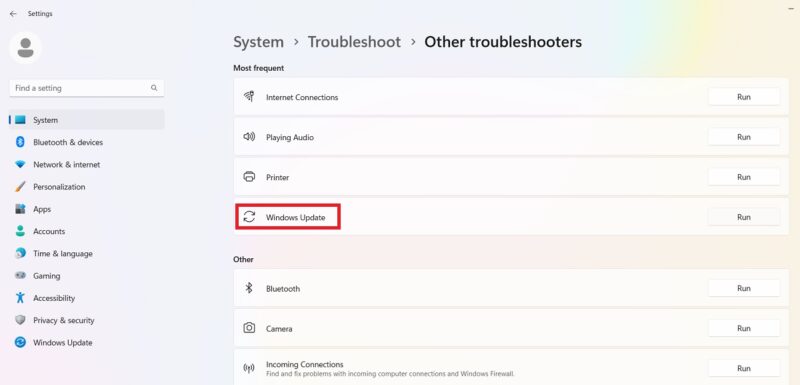
Once the troubleshooter runs, it will check for and fix any issues that were preventing installation. Those problems are mostly security settings, missing or corrupt files, or problems with Service Registration. Other issues could be connected to Windows Network Diagnostics, IsPostback_RC_PendingUpdates, WaaSMedicService, and BITS service.
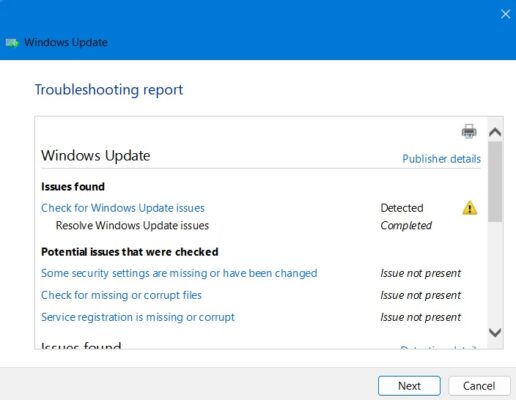
[Fixed] October 31, 2023, Windows 11 22H2, KB5031455 Cumulative Update
Problems: confusing update number | gaming performance issues
Microsoft’s Windows 11, version 22H2, KB5031455 update, is a precursor to the 23H2 release. The October 31 update serves as a transition between version 22H2, which has been running this whole year, and version 23H2.
Clearly, this one is a confusing update for many, as an identical update for version 23H2, also called “KB5031455,” was released on the same date. 22H2 carries many of the same features as 23H2, such as Windows Copilot and the Windows Backup app. It’s in preview mode, though, so the features aren’t stable.
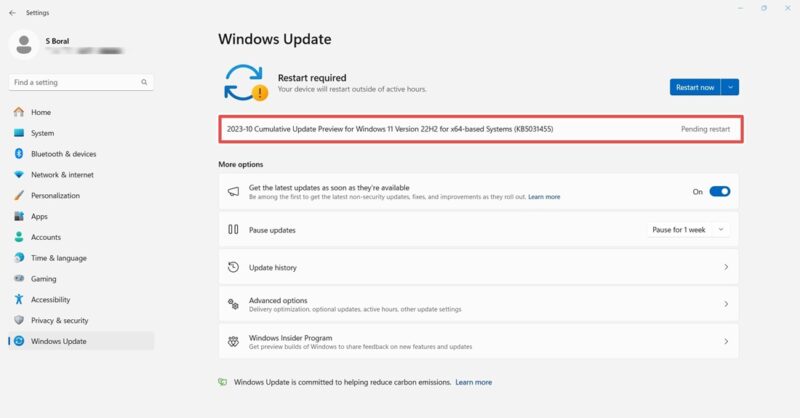
For many Windows users, the version 22H2 KB5031455 update may be the last one in the 22H2 series. While Microsoft plans to retire version 22H2 by February 2024, it will continue to launch a few intermediate updates in the 22H2 series, such as KB5032190, to assist the migration for users stuck behind in older 22H2 updates.
Some users have reported that they were facing gaming performance issues in terms of dropouts. As with the previous update KB5031354, if you’re having problems running the latest games, you may need to upgrade your graphics card.
[Fixed] October 10, 2023, Windows 11 22H2 KB5031354 Cumulative Update
Problems: failure to install | File Explorer and gaming crashes
In October 2023, Microsoft released only one cumulative update, KB5031354, which mainly fixes the security and performance issues in the previous updates. The main issue with this update is that it fails to install on some systems, presenting error codes. Additionally, some users have experienced crashes in File Explorer and CPU-intensive games, like Modern Warfare 2.
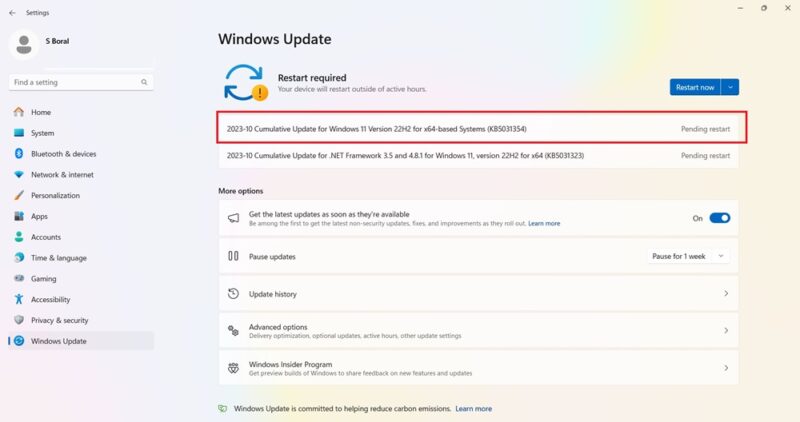
Tip: Wi-Fi not working for you on Windows? We have the fixes. Also, if you’ve run into an annoying BSOD crash during a restart, use a method covered here to resolve the issue.
Error Code 0x800f0831
Problem: update fails to install
This is one of the more common errors that may occur when you try to update Windows.
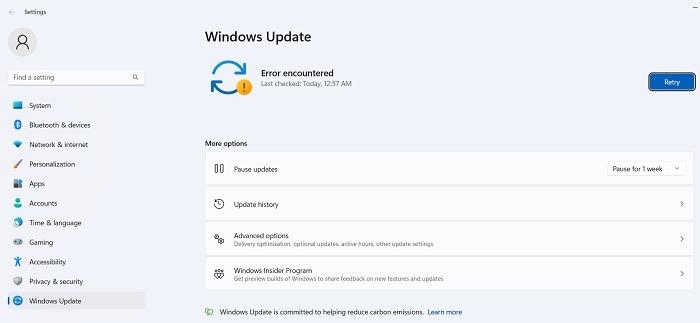
Essentially, the above error code means your update has failed, but there are several things you can do to troubleshoot this problem:
- If there’s a conflict with your VPN or proxy server, make sure it’s completely disabled when trying to update Windows. You may even need to uninstall and reinstall the software.
- Scan for corrupt system files.
- For this and other update errors, you can try finding the update in question in the Microsoft Update Catalog and install it manually.
Tip: are you facing start menu problems? We have some handy fixes that will help you unfreeze the search box in no time. We also recommend the simple method of reinstalling the Start menu. If you are also facing File Explorer problems in this update, use one of these solutions.
[Fixed] November 14, 2023, Windows 10 Version 22H2, KB5032189 Servicing Stack Update
Problems: Windows components removed, such as Notepad
Windows 10 has stopped receiving any new, exciting updates. So far, it hasn’t received the 23H2 version of Windows 11. The KB5032189 update is a minor update that addresses some security issues in Windows 10. However, there were a few problems with this update. Most notably, many users reported that some apps, such as Notepad, were missing.
Microsoft has added them as optional components in Windows 10. You can add them back from Start -> Apps -> Apps & Features -> Optional Features.
Tip: learn how to repair the .NET Framework on Windows.
[Fixed] October 26, 2023, Windows 10 Version 22H2, KB5031445 Servicing Stack Update
Problems: updates failing to install
The KB5031445 update for Windows 10 is a minor update to improve on an issue that was causing errors in touchscreens. It also fixes memory leaks and slow response time in Outlook when using Internet Printing Protocol (IPP.) The update is mostly error-free, but some users have experienced a failure to install. It can be fixed through a clean install and other methods, assuming you can’t access the desktop.
Tip: recover your apps and files using the Find My Device feature. You can also solve critical process errors by running a Deployment Image Servicing scan (DISM).
[Fixed] Error 0x80070422
Problem: updates fail to install properly
The 0x80070422 bug is one of the oldest update errors in Windows and can still affect some Windows 10 devices while installing updates. It’s often accompanied by other types of messages, such as “Windows update is disabled.” The current approach to solving this problem is to disable IPv6 from Wi-Fi Properties.
First, verify that your Windows Update service is enabled, then go to Settings -> Update & security -> Windows Update. Press Retry to ensure that the update issues are no longer there.
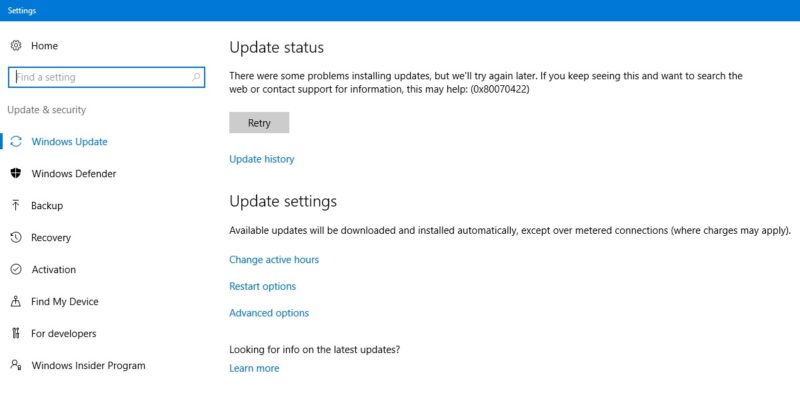
If you notice persistent failure due to the error code, go to Control Panel -> Network and Internet -> Network and Sharing Center. Double-click the available Internet connection, which will open a Wi-Fi Status pop-up window.
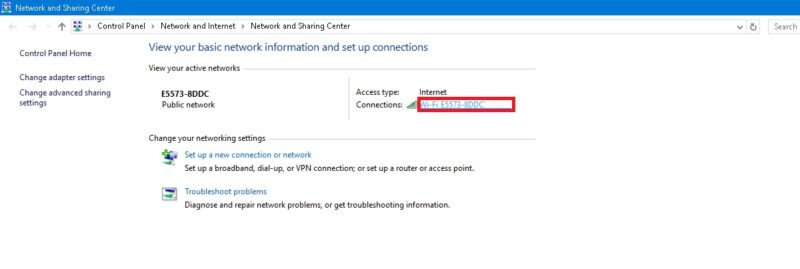
Click Properties.
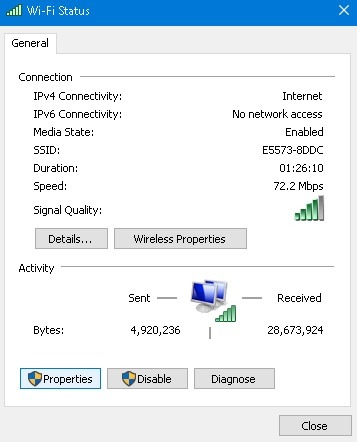
Navigate to Internet Protocol Version 6 (TCP/IPv6), and disable it.
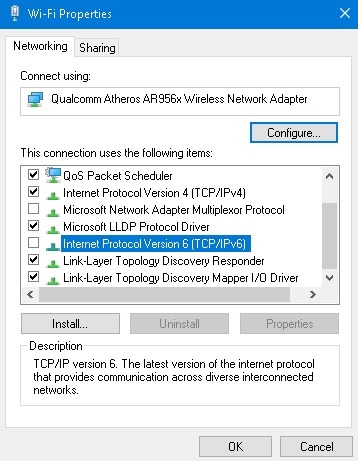
If you’re still having issues due to the error code, access the Command Prompt in admin mode, and enter the following commands one after another.
net stop wuauserv net stop cryptSvc net stop bits net stop msiserver
Restart your device, then check your Wi-Fi connection again. The 0x80070422 issues should be fixed.
Tip: there are many efficient ways to deal with a stuck Windows update, and if you’re seeing slow boot issues in general, there are solutions to get around that as well. Also, if you’re hitting 100 percent CPU usage, due to gaming or other apps, it is an easy fix.
How to Fix and Avoid Broken Windows Updates
If the problem you’ve encountered with a new Windows update is that the install stops at a certain percentage, or more generally, that it’s failing to install altogether, try installing the update from PowerShell.
Open PowerShell as administrator by typing it into the Start menu search. In PowerShell, use this command:
Install-Module PSWindowsUpdateIt may ask you to install and import the NuGet provider. Press Y for Yes, and let it install the package.
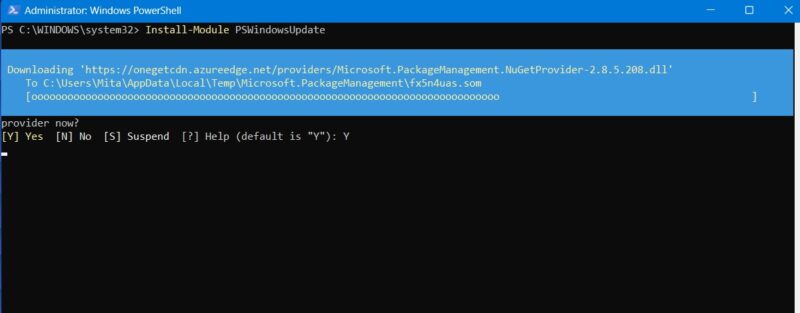
You may get a warning that you are installing the modules from an untrusted repository. Type A to allow all the changes.
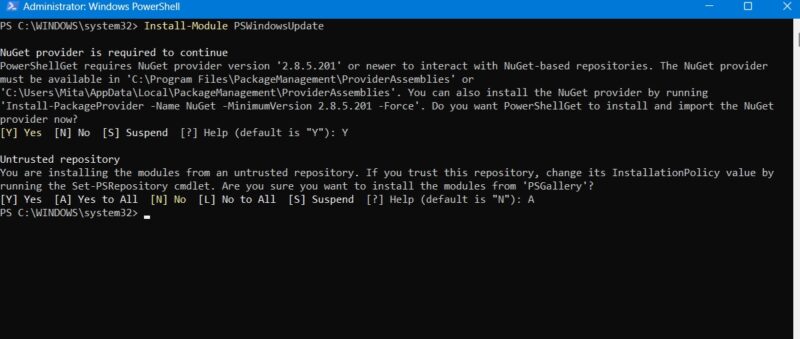
Check for the latest Windows updates by typing the following into PowerShell:
Get-WindowsUpdate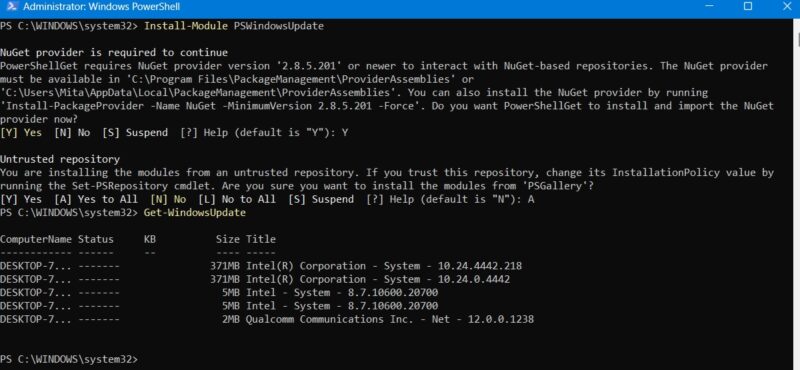
Once you’ve confirmed that there are updates to install, type the following command. You may further be asked if you want to perform this action, to which you must type A to finalize.
Install-WindowsUpdate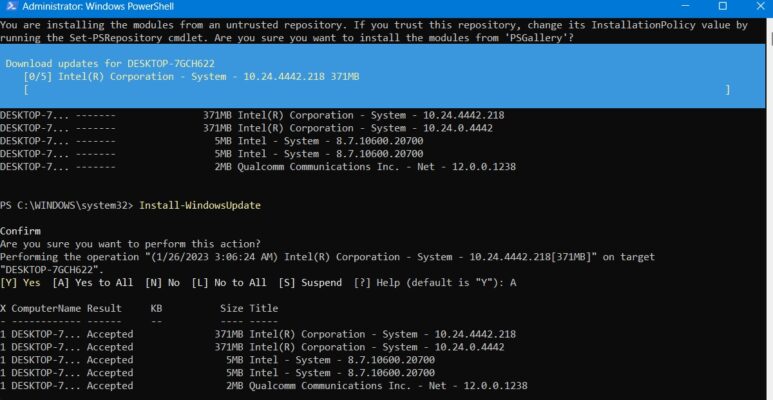
Wait for the broken Windows updates to heal themselves. They will automatically execute in the PowerShell window.
Tip: how does PowerShell differ from Command Prompt? Read on to find out.
Install Optional Updates
If you access the Windows update screen by going to Settings -> Windows Update -> Advanced Options -> Additional Options, you will find the Optional Updates menu.
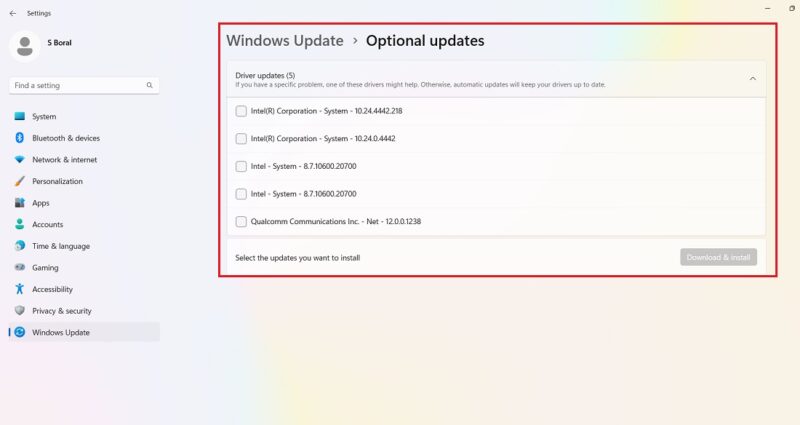
These updates are designed specifically to address feature, quality, and driver issues for recent Windows updates. They become “proper” updates a few weeks later, once they’ve been thoroughly tested.
These updates are still pretty stable, though, and may be worth a shot if a recent update has broken something in Windows.
Uninstall Windows Updates
You can uninstall smaller Windows updates (to roll back builds, see the next section) if you need to.
In Windows 10, go to Control Panel -> Programs -> Programs and Features -> Installed updates.
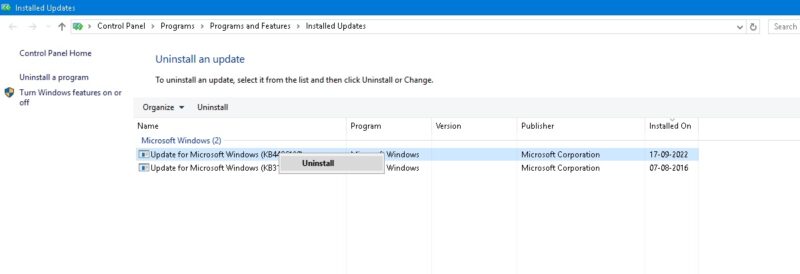
Scroll down in the main pane to the Microsoft Windows heading, and you’ll see all of the KB and security updates for Windows 10, along with the dates they were installed. Right-click the one you want to uninstall, and reboot your PC.
Windows 11 also has the option to uninstall recent updates. Visit Settings -> Windows Update -> Update History –> Uninstall updates, and click the Uninstall button next to the update you want to eliminate. In this example, we are uninstalling the KB5031354 update for the month of October 2023.
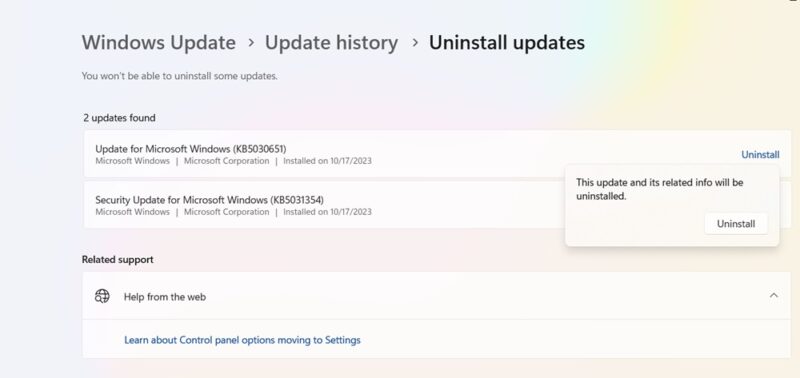
How to Roll Back Windows Builds
After every major update, Windows gives you a 10-day window to roll back to a previous version. It’s a useful feature, and should give you enough time to judge whether you have a problematic update on your hands. Of course, this won’t recover your files if Windows deletes them, but at least you’ll be on a more stable version of the OS.
Go to Settings -> Update & security -> Recovery in Windows 10 or Settings -> System -> Recovery in Windows 11.
Below Reset this PC, you should see the option to Go back to the previous version of Windows.
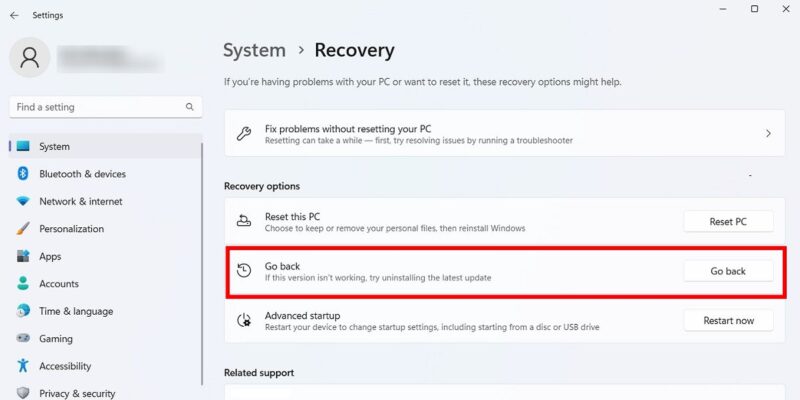
Click Get started, then follow the steps to roll back Windows. Again, this option is only available for 10 days after a Windows build update.
Check Your Windows Build
Before looking into rolling back and fixing broken Windows updates, check the build of Windows you’re currently using to confirm which issues are affecting you.
Go to Settings -> Windows Update -> Update history (in Windows 11) or Settings -> Update & Security -> Windows Update -> View Update history(in Windows 10).
In the new window, click the arrow next to Feature Updates to see the version of Windows you’re currently using, and click Quality Updates to see all of the smaller KB updates you have installed.
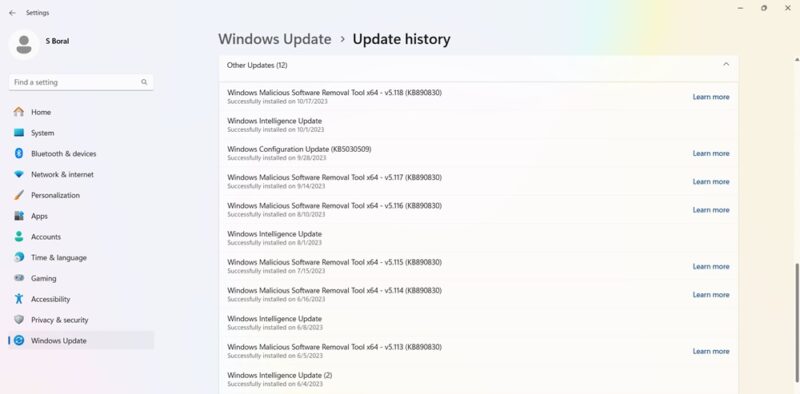
You will also find Definition Updates, which are security intelligence updates related to Microsoft Defender.
At the bottom of the list, you may find Other Updates, concerning programs such as the Windows Malicious Software Removal tool, Intelligence updates, and security patches.
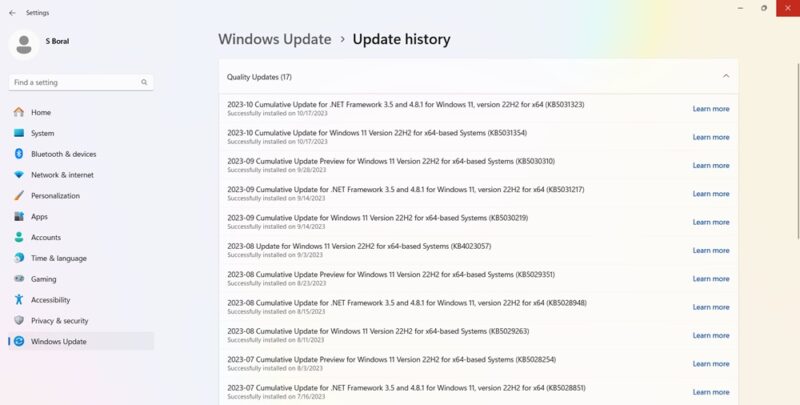
Pause Windows Updates
Another thing you can do to avoid getting the above update problems and more is to take over control when Windows updates. This way, you can hold off getting updates the moment Microsoft rolls them out, monitor the news for a bit to see if any significant errors crop up, then manually do the update yourself.
If you’re running Windows 11, go to Settings -> Windows Update -> More options -> Pause updates, and choose the number of weeks you wish to defer updates in the future (from the default of one week to up to five weeks).
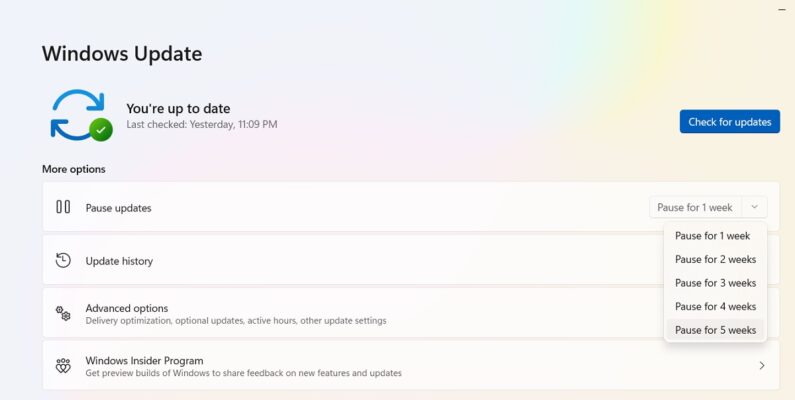
In Windows 10 Home, Pro, Enterprise, Education, or S, you can postpone updates by checking the same option available under Settings -> Update & Security -> Windows Update. On some Windows 10 versions, it may be referred to as Defer instead of Pause and available under a different heading.
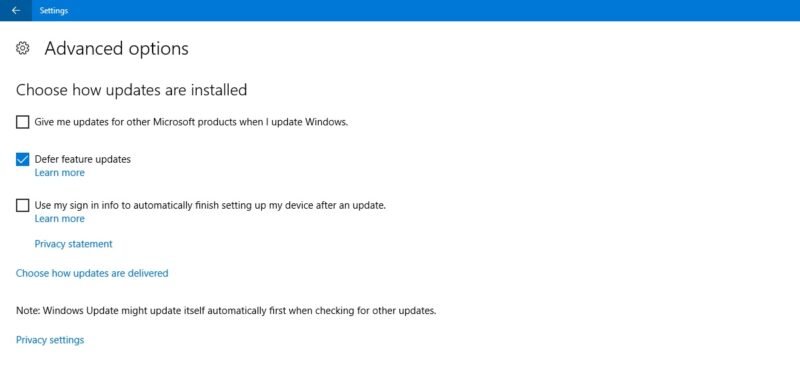
Tip: did you know that Windows comes with a Super Administrator account? Learn how to activate it.
Completely Block Windows Updates
If you want to completely block Windows updates indefinitely, disable the main Windows Update service through the Registry Editor.
Click Start, type regedit, open the Registry Editor, and navigate to the following path:
Computer\HKEY_LOCAL_MACHINE\SYSTEM\CurrentControlSet\Services\WaaSMedicSvc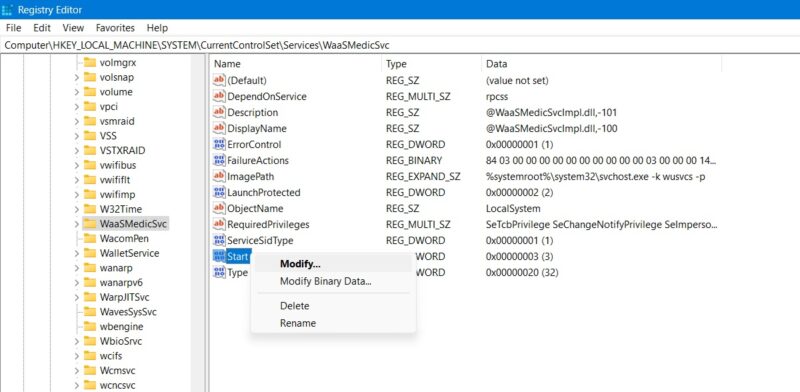
Right-click on Start to modify it, then change its Value data to 4.
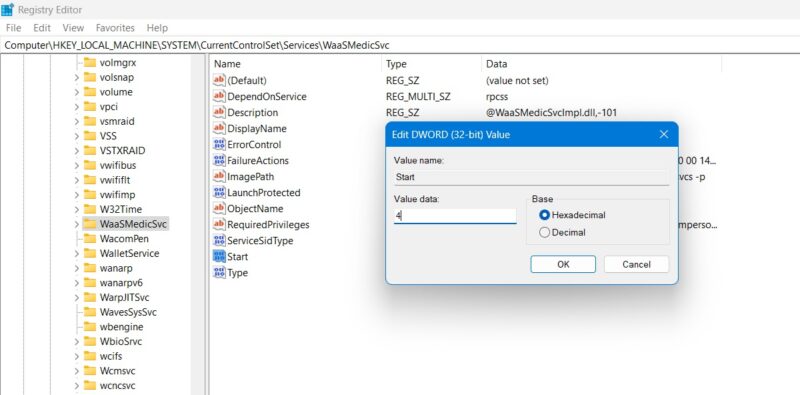
Reboot your PC, then go to the Services window by using the Search function in Windows. You can disable the Windows Update service in the same window by setting its startup type as Disabled.
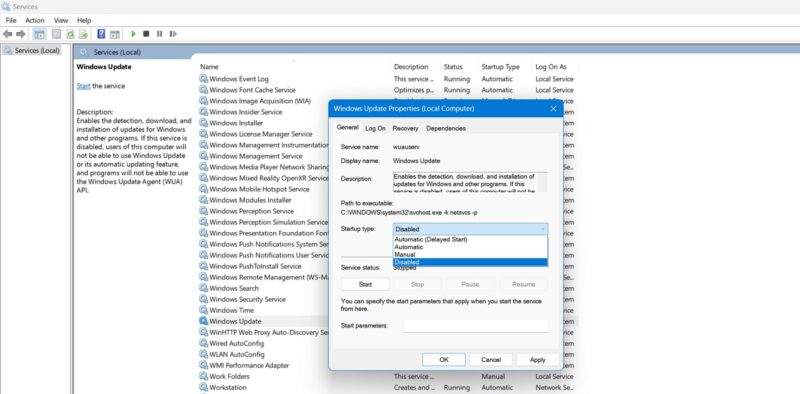
Few things on PC are more frustrating than an update – ostensibly to improve performance – borking your system. Unfortunately, Microsoft still has work to do in this respect. Other issues with Windows include taskbar icons that go missing, the Microsoft Store not working, and a malfunctioning microphone. We can help you with these, too!
Image credit: Pixabay. All screenshots by Sayak Boral.
Our latest tutorials delivered straight to your inbox